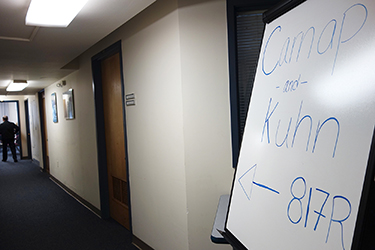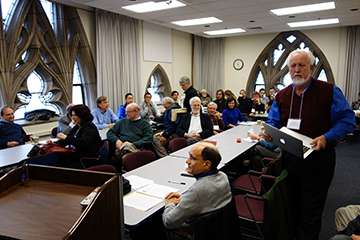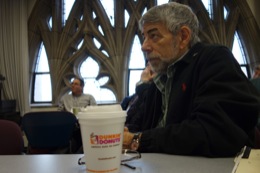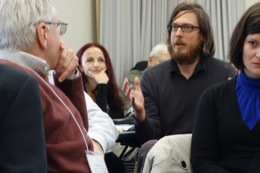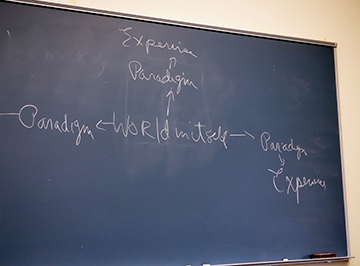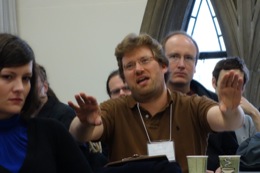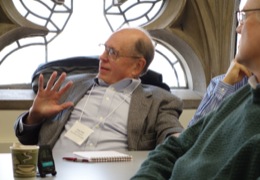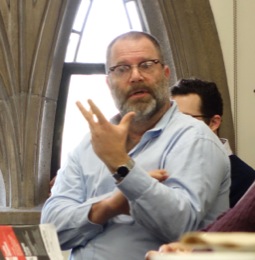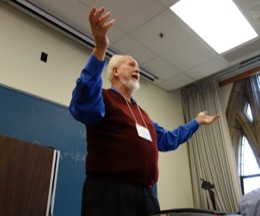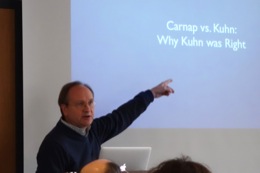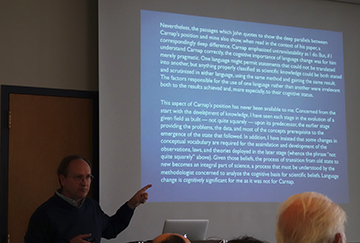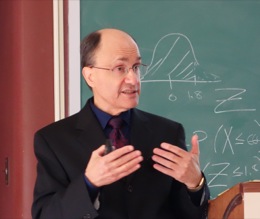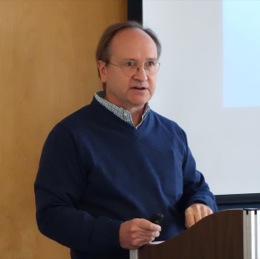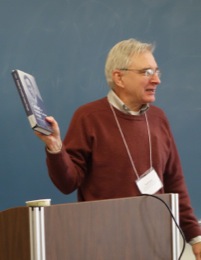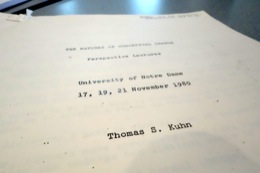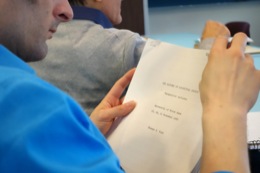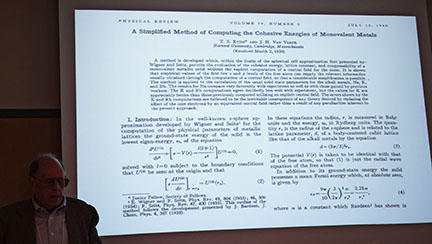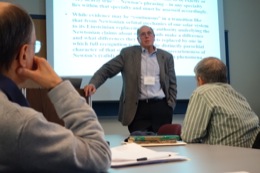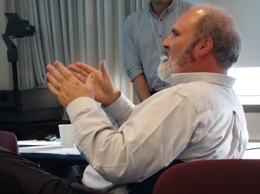
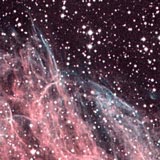
![]()
home
::: about
::: news
::: links
::: giving
::: contact
![]()
events
::: calendar
::: lunchtime
::: annual
lecture series
::: conferences
![]()
people
::: visiting fellows
::: postdoc fellows
::: resident fellows
::: associates
![]()
joining
::: visiting fellowships
::: postdoc fellowships
::: senior fellowships
::: resident fellowships
::: associateships
![]()
being here
::: visiting
::: the last donut
::: photo album
|
Carnap and Kuhn: A Reappraisal About a week ago, I finally realized that the conference would soon be upon us. My involvement had been mostly on the administrative side and it was rather light. That was because Bob Batterman had worked hard to ensure that all the little pieces needed to make the event happen would assemble at the right moment. He deserves the lion's share of the credit for the successful event that would shortly transpire. As the event neared, I began to wonder, just what is left to say about Carnap and Kuhn? Rudolf Carnap is one the most celebrated figures of the logical positive movement. We have his papers here in our Archive of Scientific Philosophy. Scholars from almost everywhere, it seems, have been poring over them and publishing. Thomas Kuhn is one of the few of our community that has broken into the public eye to become one of the most widely read and influential thinkers of his era. Many more words have already been written about him than he ever had time to write. Could there be anything left to say? My doubts evaporated when I received a call from George Smith on the Monday before the conference. He needed to confirm some minor details for his talk, later in the event. In the process, he let slip, rather too purposefully, some of the content of his talk. I was electrified and immediately decided that I could make no better use of a Saturday afternoon than to hear him. When the day arrived, the conference room filled and with more people than I'd expected for a crisp Saturday morning in the Fall. Many thought there was more to be said and they were willing to forgo a weekend to hear it.
---oOo--- Then Clark Glymour took the podium as the first speaker, carrying his notes on his computer screen. Clark continued Nick's anecdotes, but at somewhat higher wattage. In person, Clark is more Reichenbach than Carnap. He told us that he had never met Carnap, but he had been Kuhn's colleague for seven years. What followed reminded me that our task was honest, critical analysis, not eulogy: "I didn't like him much; and he didn't like me." The startling line had tumbled out so fast that Clark had mollified it before we had time to be startled. He admired Kuhn, he continued, for Kuhn was an original. The substance of Clark's talk was heralded in his title "Some questions I would have liked to ask them." Earlier in the morning, as we waited for the proceedings to begin, I had sat next to Clark, chatting idly. I'd remarked that his title had a kind of all-purpose utility that could be used for any event. Clark had not reacted. As he now developed his questions, I could see why. His questions were not perfunctory. They were the product of careful reflection. They were a serious and respectful attempt to understand better. My remark had been flippant. With real regrets, I mentally filed it among my dumber quips. For Carnap: 1. Where Quine and others thought of philosophy as science continued by other means, why did Carnap limit his ambitions merely to meta-analysis of science? 2. Carnap's magnificent "Testability and Meaning" had investigated just the right question: how do you localize the bearing of evidence? And it had been done with great clarity. Why did Carnap drop the project in favor of his probabilistic project of the later years? 3. Some of the great logical advances of recent times have come in semantics and model theory. Why did Carnap confine his analysis to syntax? Why did he subjugate everything to language? Now Kuhn: The first question needed a preparatory anecdote. Clark and Hartry Field were having lunch in the cafeteria when Hartry remarked on Kuhn's curious view. When Thomson made his discovery with cathode rays (or however it was done), that's when Kuhn believes electrons popped into existence. Did Kuhn really think that?! At that moment, Kuhn just happened to walk by. Clark stopped him and asked. "Yeah, of course," Kuhn replied and he walked away. 1. The first question is now obvious. Did Kuhn really think that? What did he think is the case? This was attached to an interesting speculation later in the talk. Kuhn, in his later years, had mentioned attachments to the neo-Kantian tradition. Might he have imagined the world as a Kantian thing-in-itself with the paradigms mediating between them to experience like Kantian categories?
3. Finally, in trying to understand how science progresses, Kuhn turned to linguistics and psychology. Why did he not look to logic? What might he have thought of the learning theoretic paradigm introduced by Hilary Putnam in the 1960s? ---oOo--- Clark had given a powerful presentation and triggered a discussion that moved quickly between moments of hilarity and serious reflection. The density of ideas provided during this and subsequent talks was so great that I cannot pretend to report fully on the talks that followed. However I was struck by one interesting contrast of academic cultures. Clark is a hard act to follow. André Carus remarked precisely on that fact when he took the podium to give the next talk. As he began to speak under the tantalizing title "Carnap vs. Kuhn: Why Kuhn was Right," I could sense another sort of difference. It is a deep one. While we were settling in our seats, André had circulated a four page handout, containing nothing but quotes from Kuhn and others who would feature in his talk. There were 17 in all, labeled A, B, ... , Q. These texts, he assured us, would be the same texts that would fill the screen, so we would have ample chance to study them. I'd seen almost exactly the same protocol the night before. Michael Friedman had spoken elsewhere in the building in an event organized by the Philosophy Department. He gave the Tamara Horowitz Memorial lecture, "Mathematical Science, Naturalism, and Normativity." Mike's goal had been to contribute to our understanding of the vexing problem of the relation of mathematical entities to our physical world. If they are otherworldly abstractions, how can they connect with the world? He would, he told us at the outset, remark on this at the end. But first there would be some preparatory work.
This difference of emphasis is a clue to something bigger: Our conceptions of the larger project are different. For these speakers, the project is a literary-historical project. First, it is literary in that the most fundamental activity is the analysis of the writings of the greats. Where the basic data of the talk for me are the theses advanced, here the basic data are the texts analyzed. The audience needs to see them and examine them. Second, it is historical. The modest theses conjured up by modern thinkers like me are mere rumbles and echoes of something grander. That something is a research program, to use Lakatos' term from elsewhere, with a history spanning the ages. We now contribute by joining one of these programs and seeking to extend it. Mike, I am assuming, conceives himself as doing that. His program has roots as far back at Plato and came to fruition in Kant's work. He can only convey what is most important by conveying that program to us in all its rich historical and textual detail. ---oOo--- It's now 4:30 and George Smith's talk is beginning. Here is what George had told me over the phone and what he was now telling everyone in the room: Kuhn had long felt that no one truly understood his views, including critics at both extremes. At the time of his death, Kuhn was preparing a book that would finally work things out and sort things out. The manuscript was incomplete. Kuhn had stalled after five chapters. A year or so prior to Kuhn's death, George received an invitation. Would he help Kuhn on the manuscript? From early October 1995 to early March 1996, George had studied the manuscript and had talked to Kuhn about how to complete it. George would now tell us what he learned.
What followed was a rather complete re-education in Kuhn's thought. Or at least is was for me. Do allow that I am not a Kuhn expert but merely a pedestrian reader of the easier parts of the Kuhn literature. What is news to me may not be to the experts. George's narrative was mingled with stories of George's interaction with Kuhn. There was talk of a manuscript still in the original envelope and of promises still kept of confidentiality. We heard of their first memorable meeting to discuss the manuscript at Legal Seafoods in Boston near MIT. There was a Kuhn typescript passed around for us to glance at, then pass on. It was marked "not for quotation."
More interesting was Kuhn's hope that he could reaffirm the authority of scientific knowledge. Once again, the popular image of Kuhn was of someone intent on destroying that authority. Kuhn's real concern was the reverse of this, that the authority of science had been undermined by historical philosophy of science. How could it be restored? He saw the traditional hope as looking to the correspondence theory of truth: science gains its authority in the correspondence between its claims and the facts of the world. That traditional answer failed, Kuhn thought, for there seemed no way to reconcile it with the need to choose between incompatible scientific laws. As science develops and theories change, we must admit failure of the correspondence in the earlier theories. Kuhn had argued famously that different scientific paradigms were incommensurable. One could not compare claims between paradigms. Scientists working in one paradigm would find the claims of scientists in the other paradigm incomprehensible. Hence no final decision could be made between competing paradigms, for any such decision must be made from within one or other. That seemed to be the surest sign of Kuhn's deeply relativist view, that there can be no truth, but only truth relative to one or other standpoint. That sort of truth is not the sort that can sustain the authority of science. What followed was the most radical part of my re-education. George now explained that Kuhn saw incommensurability in exactly the opposite way. The impossibility of comparison is what protected science from the harsh judgments of falsity of the correspondence theory of truth. There is no higher perspective from which to judge winners and losers among the paradigms. Rather--and this is the core idea--the authority of science comes locally within each paradigm. Each provides its own methods and standards of success. That was quite a story. But it was only the first half. George had decided that if he wanted to understand Kuhn properly, he had to know him better and in the right way. We are all formed by our education in ways we may never fully appreciate. We should take seriously, George insisted, that Kuhn's training was not as a historian or a philosopher, but as a practicing physicist. Kuhn's ideas on the structure of science had started to form in 1948 when he was assisting James Conant at Harvard teach history of science. During that same time, from 1947 to 1949, Kuhn was also working under John Van Vleck on a doctorate in solid state physics. How had that prepared Kuhn? George pointed to a key disciplinary fact in the physics of that era. Quantum physics was not one theory. It had divided into several sub-disciplines: an abstract quantum theory, chemistry and molecular bonding theory, solid state physics and more. These were each largely independent studies with their own methods and standards. One of them might judge success to be agreement of theory and experiment to six significant figures. Another might ask only for two. They were like distinct paradigms, each practicing their own version of normal science. Kuhn's advisor, Van Vleck, was adept in two of these sub-disciplines, solid state physics and molecular bonding. George showed us the first page of the article in physics that Kuhn had coauthored with Van Vleck. Might Kuhn's experience with these sub-disciplines have informed his view of science? George thought so and pointed us to an intriguing and overlooked section of Kuhn's famous Structure of Scientific Revolutions. On page 50, Kuhn had talked about these different sub-disciplines as distinct paradigms. "What quantum mechanics means to each," Kuhn wrote, "depends upon what courses he has had, what texts he has read, and which journals he studies." In the concluding minutes of his talk, George assured us that Kuhn wanted to secure an authority for science that was as good as that promised by a correspondence theory of truth. The story is not over. In the week he died, Kuhn was dictating material to Jim Conant and John Hoagland that was to be used in the final version of his manuscript. That work still remains unpublished. I now have a new and more sympathetic image of Thomas Kuhn. He frequently protested that he had not been understood, perhaps even by those who found his work convincing. That must have made his fame lonely. He was celebrated for an achievement he believed he did not make. More than ever, I now see his success in his convincing others that he had found a perspective on science of great importance. The failure was that he never had the perspective worked out, or at least he never had one that he could formulate precisely enough to communicate to others. John D. Norton
|
